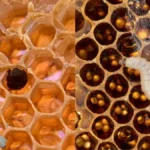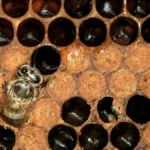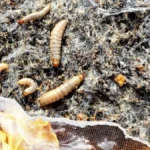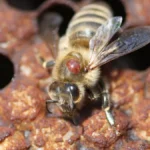The small hive beetle or Aethenia tumida is an opportunistic pest that can bring both destruction, and a few benefits, to your apiary. In this article, we take a look at how to control these irritating pests and how to manage small hive beetle treatment.
In 1997 I was a young beekeeper in South Africa. I subscribed to a few early beekeeping groups on the internet and when the small hive beetle arrived in the US, all the beekeepers started asking me questions about this pest. It is an indigenous beetle to South Africa, and hence I was able to make notes on what our bees here did to the beetle.
I remember watching my Apis mellifera capensis honeybees – I would find a hive beetle and drop it on the brood. I even pinned a beetle with an insect pin, attaching it firmly to the brood. The Cape honeybee does not like the small hive beetle. When they see small hive beetles, they first try to chew the legs off, then they propolize the beetle into a cage and kill it.
The beekeepers I chatted to in the US at the time repeated the same experiments, and with Italian and New world Carnolians they saw a lot less defensive behavior. The beetles were able to run into the brood, and the bees largely ignored them. And thus a disaster began.
What Is The Small Hive Beetle?
Origin
The small hive beetle is a pest of African bees – it is found throughout Africa and parasitizes brood. The females dart into the brood nest, and pollen stores laying eggs which then hatch and eat the brood. The larval stages produce a terrible stench and, if left unchecked, hive beetles will turn the entire brood nest into a seething mass of larvae. The beetles carry certain bacteria and yeast, specifically Kodamaea ohmeri. These microbes infect the honey and nectar in the hive and turn this into a sour horrible smelling froth.
This pest has now become established globally with beetles having been detected in most of North America, parts of South America, the EU, Australia, and the Indian Ocean Islands. Non-African bees are less able to deal with this pest than African bees. In Africa, the beetle is only really a pest if hives are weak.
Egg-laying In The Hive
The small hive beetle, or Aethina tumida, has a lifecycle which if you understand it, can allow you to control the pest. The male and female beetles mate, and after this, the female scurries around trying to lay eggs in brood and pollen. After three to four days, the eggs hatch, and the larvae burrow through the combs eating brood and pollen. They defecate and this makes the nectar and honey go sour.
The larvae look a little like wax moth larvae. They are however a lot tougher – try and squash one with your fingers and you will find it is much harder and more difficult to kill than a wax moth larvae.
Pupation
After 10 days to two weeks, the larvae are around half an inch long. I have watched bees carry these larvae out of the hive – the bees seem to struggle to kill the larvae. Once outside the hive, the larvae burrow into the ground. The next step is pupation – published data suggests that this takes about 3-4 weeks. I suspect that the pupation is faster when temperatures are higher and have noticed beetles doing mass emergences after two and a half weeks.
Return To The Hive
The pupated beetles emerge and mate and return to the hive. This results in more damage to the hive, and more eggs – the increase is explosive in number. If your bees are not able to control the hive beetle, the result is that the beetles render the hive uninhabitable. The bees abscond, and you arrive to find foamy stinky honey dripping from the entrance of your hive. The process will repeat over and over until the season cools down.

Small Hive Beetle Treatment
Honey House Hygiene
Hive beetles are opportunistic pests. If you allow them to get into brood and pollen that is not in a hive, they will multiply in this and then return to harass hives. The first step to controlling beetles is good honey house hygiene. Do not leave supers stacked for long periods of time before processing. This can lead to beetle multiplication.
UV Light Bug Trap In The Honey House
I place one of these in my honey house. This helps to control adult hive beetles as they fly to the bug zapper and get blasted at night. It is also great as it mops up robber bees that come and try to rob your honey house. The reason you buy a bigger unit such as the one I showed in the link is that small units get overwhelmed by bees and beetles. You need a larger unit that is easy to clean.
Beetle Traps
One of the best ways to control hive beetles in your hives is with a beetle trap. There are many designs, but seeing as we live in a plant with declining ecological quality, let us look at a reusable example. This is a very well-designed beetle trap. It is reusable. The way it works is you put a bit of bait in the central compartment and mineral or vegetable oil in the side compartments. The beetles try to get to the bait and end up falling in the oil and drowning.
For bait, it is possible to use a bit of apple cider vinegar. I have found something that works really well. If you mix a bit of mead with a bit of live apple cider vinegar, it smells very attractive to the beetles. Drink the rest of the mead. Fermented honey has a smell that is very attractive to beetles.
The traps fit between the frames and are very inexpensive. Beetles are fond of crevices and dark spots where bees cannot get. Because the beetle traps have holes that are smaller than bee space, it is necessary to clean the propolis out of the holes. Because beetle control is really a numbers game, if your traps catch ten to twenty beetles each, you are removing those beetles from circulation. Keeping beetles below the threshold where they cause trouble is ideal.
Poisons
There are options where you can use chemical pesticides such as Coumaphos in the hive for small hive beetle treatment. I try to steer clear of these sorts of poisons as they are actually just bad news. Residues accumulate in wax and even honey, and we cannot really speculate on the long-term effects on the bees.
I hope this article has helped you understand how to safely, and consistently try and control small hive beetles. It is a numbers game, and keeping their numbers down is the best thing you can do for small hive beetle treatment. If you enjoyed this, please share.
Small Hive Beetle FAQs
What are small hive beetles and why are they a threat to beehives?
Small hive beetles (Aethina tumida) are parasitic pests that infest hives, laying eggs in the brood and pollen. Their larvae destroy combs, spread disease, and cause honey to ferment, severely impacting hive health.
Where do small hive beetles come from?
Small hive beetles are native to sub-Saharan Africa, where local bees have adapted to combat them. They have since spread globally, including to North America, Australia, and parts of Europe, where bees are less equipped to handle them.
How do small hive beetles reproduce in a hive?
Female beetles lay eggs in cracks and crevices within the hive. These eggs hatch into larvae that consume the hive’s pollen, honey, and brood. The larvae then burrow into the soil to pupate before emerging as adult beetles, returning to the hive.
What are the signs of a small hive beetle infestation?
Signs include slimy, fermented honey, a foul smell, beetle larvae visible on the comb, and bees abandoning the hive. The brood may also appear damaged, and hive activity may decrease significantly.
How can beekeepers prevent small hive beetle infestations?
Good hive management is key, including maintaining strong colonies, avoiding leaving honey supers unprocessed, keeping the hive clean, and using traps or screens to catch beetles before they multiply.
What are some natural treatment options for small hive beetles?
Beekeepers can use beetle traps baited with apple cider vinegar or a combination of mead and vinegar. Strong colonies with hygienic behaviors also help keep beetle populations in check.
How do beetle traps work in managing small hive beetles?
Beetle traps typically contain bait that attracts beetles, which then fall into compartments filled with oil and drown. Regularly cleaning and placing these traps in strategic spots within the hive can reduce beetle numbers.
Can pesticides be used to treat small hive beetles?
While chemical treatments like Coumaphos are available, they should be used cautiously due to potential residue build-up in honey and wax. Many beekeepers prefer natural methods to avoid harming their bees and contaminating their products.
How does soil around the hive affect small hive beetle pupation?
After feeding, larvae leave the hive to pupate in the soil. If the soil is sandy or loose, it can aid their pupation. Treating the soil around hives with diatomaceous earth or nematodes can help prevent beetles from maturing and returning to the hive.
What role does honey house hygiene play in preventing small hive beetles?
Maintaining a clean honey house is crucial. Beetles are attracted to honey and pollen residues left in unprocessed supers or equipment, so keeping the honey house clean and free of beetle breeding grounds helps reduce infestations.

Dr. Garth A. Cambray is a Canadian/South African entrepreneur and beekeeper with 28 years of experience in apiculture and specializes in adding value to honey. His Ph.D. research developed a new advanced continuous fermentation method for making mead that has resulted in a number of companies globally being able to access markets for mead. His company, Makana Meadery, exports honey mead to the USA where it is available to discerning connoisseurs. He has also developed technologies to commercially manufacture organic honey vinegar in Zambia for export globally. He holds a few patents globally in the ethanol industry and believes in technology and knowledge transfer for human development and environmental sustainability. One of his proudest achievements is the fact that the wind farm he started at one of his old apiary sites has essentially made his hometown carbon neutral.






